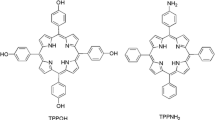Summary
Iproplatin is structurally unique among the platinum (Pt) agents in the clinic because it is a quadrivalent complex. On the basis of the redox parameters for the Pt(IV) and Pt(II) oxidation states in a chloride system, it has been suggested that Pt(IV) complexes will be reduced to Pt(II) complexes in a biological environment [7]. To test this hypothesis, uptake and metabolism studies of [14C]-iproplatin were carried out in L1210 cells. The L1210 cells raised in DBA2/J mice were incubated in vitro with 50 and 100 μM [14C]-iproplatin at 37°C in Hanks' balanced salt solution, and total uptake and radioactivity associated with acid-insoluble fractions were measured for up to 3 h. Under these conditions, the uptake of iproplatin was linear with time and increased with increasing concentrations of iproplatin in the medium. At all times measured, >35% of radioactivity was associated with the acid-insoluble fraction, suggesting binding to macromolecules. The [14C]-labelled compounds in neutralized acid extracts of cells were separated by reverse-phase high-performance liquid chromatography (HPLC). Three labelled compounds were detected; based on chromatographic elution times, they appeared to be iproplatin,cis-dichloro-bis-isopropylamine platinum(II) (CIP), the reduction product of iproplatin, and a third compound more polar than iproplatin and CIP. The finding of free CIP and the macromolecular binding of radioactivity in the cells suggests that iproplatin is reduced intracellularly.
Similar content being viewed by others
References
Al-Sarraf M, Kish J, Ensley J, Metch B, Rinehart J, Schuller D, Coltman C (1987) Activity and toxicity of CBDCA and CHIP in patients with recurrent and advanced head and neck cancer. Proc Am Soc Clin Oncol 6: A485
Anderson H, Wagstaff J, Crowther D, Timms B, Palmer P (1986) Comparative toxicity of cisplatin, carboplatin and iproplatin in combination with cyclophosphamide in patients with advanced epithelial ovarian cancer. NCI EORTC Symp New Drugs Cancer Ther 1: 24
Blatter EE, Vollano JF, Krishnan BS, Dabrowiak JC (1984) Interaction of the antitumor agentscis, cis, trans-Pt IV (NH3)2Cl2(OH)2 andcis, cis, trans-Pt IV [(CH3)2 CHNH2]2 Cl2(OH)2 and their reductive products with PM2 DNA. Biochemistry 23:4817–4820
Blatter EE, Vollano JF, Krishnan BS, Dabrowiak JC (1985) Platinum (IV) antitumor agents. Prog Clin Biol Res 172: 185–191
Bradner WT, Rose WC, Huftalen JB (1980) Antitumor activity of platinum analogs. In: Prestayko AW, Crooke ST, Carter SK (eds) Cisplatin, current status and new developments. Academic New York, pp 171–182
Bramwell VHC, Crowther D, O'Malley S, Swindell R, Johnson R, Cooper EH, Thacher N, Howell A (1985) Activity of JM-9 in advanced ovarian cancer: a phase I–II trial. Cancer Treat Rep 69: 409–416
Cleare MJ (1977) Some aspects of platinum complex chemistry and their relation to antitumor activity. J Clin Hematol Oncol 7: 1–25
Cleare MJ, Hydes PC, Hepburn DR, Malerbi BW (1980) Antitumor platinum complexes: structure-activity relationships. In: Prestayko AW, Crooke ST, Carter SK (eds) Cisplatin, current status and new developments. Academic Press, New York, pp 149–170
Dabrowiak JC, Bradner WT (1986) Platinum antitumor agents. Prog Med Chem 24: 129–158
Drobnik J (1983) Antitumor activity of platinum complexes. Cancer chemother Pharmacol 10: 145–149
Hortobagyi G, Holmes F, Frye D, Hug V, Fraschini G (1987) A phase II study of CHIP in metastatic breast cancer (MBC). Proc Am Assoc Cancer Res 28: 1198
Lira Puerto V, Carrgati A, Muggia F, Colombo N, Pavlosky S (1986) CHIP vs CBDCA in recurrent and metastatic cervix cancer. Proc Am Soc Clin Oncol 5: 119
Madajewicz S, Takita H, Creaven PJ, Bareniewski H, Regal AM, Cushman K (1984) Phase II study of iproplatin (IPP) in small cell carcinoma of the lung (SCLL). Proc Am Soc Clin Oncol 3: 224
Pendyala L, Greco W, Cowens JW, Madajewicz S, Creaven PJ (1983) Pharmacokinetics ofcis-dichloro-trans-dihydroxy-bis-isopropylamine Pt IV (CHIP) in patients with advanced cancer. Cancer Chemother Pharmacol 11: 23–28
Pendyala L, Cowens JW, Madajewicz S, Creaven PJ (1984) Clinical pharmacokinetics ofcis-dichloro-trans-dihydroxy-bis-isopropylamine platinum IV. In: Hacker MP, Douple EB, Krakoff IH (eds) Platinum coordination complexes in cancer chemotherapy. I.H. Krakoff. Martinus-Nihoff, Boston, pp 114–125
Pendyala L, Madajewicz S, Creaven PJ (1985) Effect of renal function impairment on iproplatin pharmacokinetics and relation to toxicity. Cancer Res 45: 5936–5938
Pendyala L, Cowens JW, Chheda GB, Dutta SP, Creaven PJ (1988) Identification ofcis-dichloro-bis-isopropylamine platinum(II) as a major metabolite of iproplatin in humans. Cancer Res 48: 3533–3536
Pendyala L, Krishnan BS, Walsh JR, Arakali AV, Cowens JW, Creaven PJ (1989) Studies on the human metabolism of iproplatin. Cancer Chemother Pharmacol 25: 10–14
Pendyala L, Arakali AV, Sansone P, Cowens JW, Gupta-Burt S, Poirier MC, Creaven PJ (1988) DNA binding of iproplatin (IP) and its metabolitecis-dichloro-bis-isopropylamine platinum II (CIP). Proc Am Assoc Cancer Res 29: 1368
Zwelling LA, Kohn KW (1982) Platinum complexes. In: Chabner B (ed) Pharmacological principles of cancer treatment. W. B. Saunders, Philadelphia pp 309–339
Author information
Authors and Affiliations
Rights and permissions
About this article
Cite this article
Pendyala, L., Walsh, J.R., Huq, M.M. et al. Uptake and metabolism of iproplatin in murine L1210 cells. Cancer Chemother. Pharmacol. 25, 15–18 (1989). https://doi.org/10.1007/BF00694332
Received:
Accepted:
Issue Date:
DOI: https://doi.org/10.1007/BF00694332




